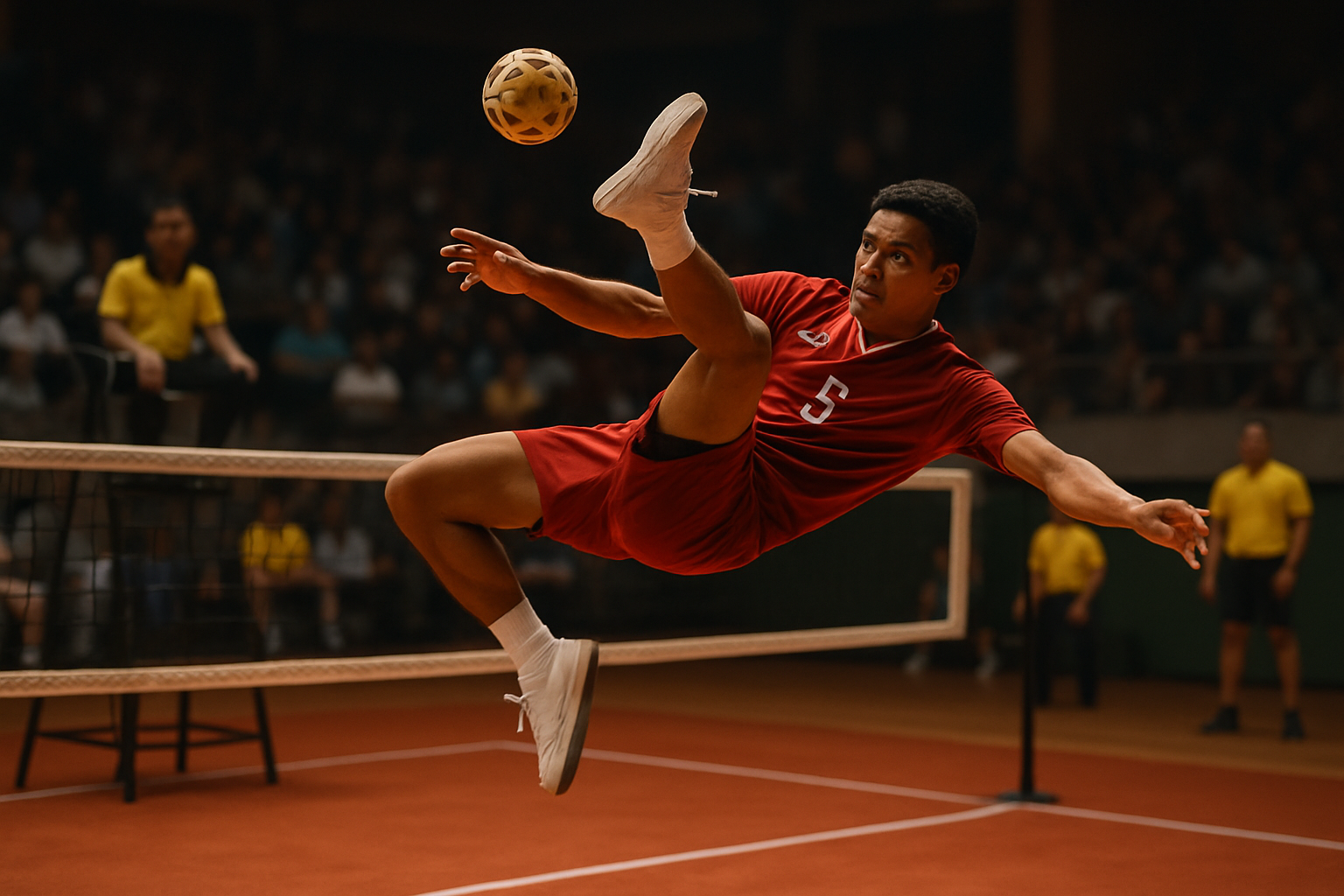The Intricacies of Sepak Takraw: Southeast Asia's Aerial Ballet
In the heart of Southeast Asia, a sport unfolds that defies gravity and pushes the boundaries of human agility. Sepak Takraw, often described as a fusion of volleyball, soccer, and gymnastics, captivates spectators with its high-flying acrobatics and lightning-fast reflexes. This centuries-old game, deeply rooted in Malay culture, has evolved from a casual pastime to a competitive spectacle that showcases the pinnacle of athletic prowess. As we delve into the world of Sepak Takraw, we'll uncover the rich tapestry of tradition, technique, and teamwork that makes this sport a true marvel of human athleticism.

In Malaysia, it was known as “sepak raga jaring,” while in the Philippines, a similar game called “sipa” was played. The modern form of Sepak Takraw began to take shape in the 1940s, with the first official rules established in 1960. The sport’s cultural importance cannot be overstated; it embodies the agility, creativity, and communal spirit that are hallmarks of Southeast Asian culture.
As Sepak Takraw evolved, it became more than just a game. It became a symbol of national pride and identity for many Southeast Asian countries. Annual tournaments and friendly matches between villages strengthened community bonds and passed down traditions from one generation to the next. The sport’s inclusion in regional competitions like the Southeast Asian Games in 1965 marked its transition from a local pastime to a recognized international sport.
The Mechanics of Play
At first glance, Sepak Takraw might appear chaotic, with players contorting their bodies in mid-air to strike a small woven ball. However, the sport follows a structured set of rules and requires immense skill and precision. Played on a court similar in size to a badminton court, two teams of three players each face off across a net standing 1.52 meters high.
The objective is simple: keep the ball in play and score points by grounding it on the opponent’s side of the court. What sets Sepak Takraw apart is the prohibition of using hands or arms; players must use their feet, knees, chest, and head to control and strike the ball. This restriction leads to spectacular displays of acrobatic kicks, including the signature “spike” move where players leap and twist in the air to smash the ball downward with their feet.
Each team typically consists of a “tekong” (server), two “feeders” or “setters” positioned in front, and three reserves. The server initiates play with a high kick from within their serving circle, aiming to clear the net and land the ball in the opponent’s court. The receiving team then has three touches to return the ball, often setting up for a powerful spike to end the rally.
The game’s pace is frenetic, with rallies lasting mere seconds but packed with intense action. Points are scored on every serve, regardless of which team is serving, with games typically played to 21 points in a best-of-three sets format. This scoring system ensures that matches are fast-paced and exciting from start to finish.
Physical Demands and Training
The physical demands of Sepak Takraw are extraordinary, requiring a unique combination of strength, flexibility, agility, and spatial awareness. Players must develop incredible lower body strength to generate power for kicks and jumps, while maintaining the flexibility to perform splits and twists in mid-air. Core strength is crucial for maintaining balance and control during acrobatic maneuvers.
Training for Sepak Takraw is as diverse as the skills required to play it. Players often incorporate elements of gymnastics, martial arts, and traditional strength training into their regimens. Plyometric exercises are essential for developing explosive power, while yoga and stretching routines help maintain the flexibility needed for high kicks and aerial maneuvers.
Footwork drills are a cornerstone of Sepak Takraw training, with players practicing intricate patterns to improve their control and precision with the ball. Many athletes spend hours perfecting their timing and technique for the all-important spike, often using specially designed rigs that allow them to practice their aerial skills safely.
Mental preparation is equally important. The fast-paced nature of the game demands split-second decision-making and unwavering focus. Players must anticipate their opponents’ moves while coordinating seamlessly with their teammates. Visualization techniques and meditation are often employed to enhance mental acuity and maintain composure under pressure.
Equipment and Court Specifications
While Sepak Takraw may seem complex in execution, the equipment required is relatively simple. The star of the show is the takraw ball itself, traditionally made from rattan but now often constructed from synthetic materials for durability and consistency. The ball typically measures about 13-14 centimeters in diameter and weighs between 170-180 grams.
The court dimensions are precise, measuring 13.4 meters long and 6.1 meters wide. The net height is set at 1.52 meters for men and 1.42 meters for women. The serving circle, where the server must remain during the serve, has a radius of 0.3 meters and is positioned in the center of each court, 2.45 meters from the net.
Players typically wear lightweight, breathable uniforms that allow for maximum mobility. Footwear is especially important, with many players opting for thin-soled shoes that provide a good feel for the ball while offering adequate support for the high-impact movements.
The simplicity of the equipment belies the complexity of the sport. It’s not uncommon to see players practicing with makeshift courts and balls in parks and streets across Southeast Asia, a testament to the sport’s accessibility and enduring popularity at the grassroots level.
Global Spread and Competitive Landscape
While Sepak Takraw remains most popular in Southeast Asia, its appeal has begun to spread globally. The formation of the International Sepaktakraw Federation (ISTAF) in 1988 marked a significant milestone in the sport’s international development. ISTAF now boasts over 30 member countries, with teams from as far afield as Germany, Canada, and the United States participating in international competitions.
The Asian Games have been a significant platform for Sepak Takraw since its inclusion in 1990. Thailand has historically dominated the sport, with Malaysia and Myanmar also fielding strong teams. The competition at the Southeast Asian Games is particularly fierce, with nations vying for regional supremacy in a sport that holds deep cultural significance.
Efforts to include Sepak Takraw in the Olympic Games have been ongoing, with proponents arguing that its unique blend of athleticism and cultural heritage would make it a compelling addition to the Olympic program. While this goal remains unrealized, the sport continues to gain recognition and followers worldwide.
The competitive landscape is evolving, with countries outside Southeast Asia making strides in developing their Sepak Takraw programs. Japan, for instance, has invested significantly in the sport, seeing it as a natural fit for their athletes’ agility and discipline. In North America, Sepak Takraw has found a niche following, with annual tournaments attracting teams from across the continent.
Challenges and Future Prospects
Despite its rich history and thrilling gameplay, Sepak Takraw faces several challenges as it seeks to expand its global footprint. One of the primary hurdles is the sport’s complexity, which can make it difficult for newcomers to understand and appreciate. Education and exposure are key to overcoming this barrier, with many national federations focusing on grassroots development and school programs to introduce the sport to younger generations.
Another challenge lies in the physical demands of the sport. The risk of injury, particularly to the knees and ankles, is a concern that needs to be addressed through improved training methodologies and protective equipment. Some countries have experimented with modified versions of the game for beginners, using softer balls and lower nets to ease the learning curve and reduce injury risk.
Funding and sponsorship remain ongoing challenges, particularly for countries where the sport is not yet well-established. However, as Sepak Takraw gains more international exposure, there is growing interest from sponsors attracted by the sport’s dynamic nature and potential for spectacular highlight reels.
The future of Sepak Takraw looks promising, with technological advancements opening up new possibilities. High-speed cameras and motion analysis software are being employed to help athletes refine their techniques, while virtual reality training programs could revolutionize how players practice and prepare for competitions.
There’s also a push to make the sport more spectator-friendly, with discussions around rule modifications to increase scoring and reduce downtime. Some tournaments have experimented with instant replay systems and challenge mechanisms similar to those used in tennis, adding an extra layer of strategy and engagement for both players and fans.
The Cultural Impact Beyond the Court
Sepak Takraw’s influence extends far beyond the confines of the court. In many Southeast Asian countries, the sport serves as a cultural ambassador, promoting traditional values and fostering a sense of national identity. It’s not uncommon to see Sepak Takraw featured in cultural festivals, where exhibition matches showcase the sport’s artistry alongside other traditional performances.
The sport has also inspired various forms of art and media. Documentaries exploring the lives of Sepak Takraw athletes have shed light on the dedication and sacrifices required to excel in this demanding discipline. In literature and film, the sport often serves as a metaphor for life’s challenges and the importance of teamwork and perseverance.
Sepak Takraw has found its way into educational curricula as well, with some countries incorporating it into physical education programs. Proponents argue that the sport not only promotes physical fitness but also develops important life skills such as spatial awareness, quick decision-making, and teamwork.
The sport’s eco-friendly nature, requiring minimal equipment and space, aligns well with growing environmental consciousness. In urban areas with limited space for traditional sports fields, Sepak Takraw courts can be set up in small parks or even on streets, providing accessible recreational opportunities for communities.
Innovation and Adaptation in Modern Sepak Takraw
As Sepak Takraw evolves in the 21st century, innovation plays a crucial role in its development. Biomechanical studies are helping to refine techniques and develop new strategies. Coaches are incorporating data analytics to optimize team formations and player matchups, bringing a new level of tactical depth to the game.
Equipment manufacturers are experimenting with new materials for both the ball and players’ gear. Prototype takraw balls with embedded sensors could provide real-time data on ball speed and spin, enhancing both training and spectator experience. Similarly, advances in footwear design are focusing on improving grip and reducing impact stress on players’ joints.
The digital age has opened up new avenues for fan engagement. Live streaming platforms have made it possible for Sepak Takraw matches to reach a global audience, while social media has created communities of enthusiasts who share techniques, discuss strategies, and organize grassroots tournaments.
Virtual Sepak Takraw games are also gaining popularity, introducing the sport to a new generation of digital natives. These games not only provide entertainment but also serve as educational tools, helping players understand the rules and basic strategies of the sport.
Sepak Takraw’s Role in Cultural Diplomacy
Sepak Takraw has increasingly been recognized as a tool for cultural diplomacy. International tournaments serve as platforms for cultural exchange, bringing together athletes and spectators from diverse backgrounds. These events often feature cultural showcases alongside the sporting competition, offering a holistic representation of the host country’s heritage.
Several countries have begun using Sepak Takraw as part of their sports diplomacy initiatives. Exchange programs allow athletes and coaches to travel abroad, sharing their knowledge and fostering international goodwill. These exchanges not only improve the standard of play globally but also promote cross-cultural understanding and friendship.
In regions with historical tensions, Sepak Takraw has sometimes served as a bridge-building tool. Friendly matches and joint training camps have been organized between nations, using the shared love of the sport to facilitate dialogue and cooperation at the grassroots level.
The Science of Sepak Takraw
The unique demands of Sepak Takraw have attracted the attention of sports scientists eager to unravel the biomechanics behind the sport’s acrobatic moves. Studies have focused on the kinetics and kinematics of the spike, analyzing the complex interplay of muscle groups and joint movements that enable players to generate such power and precision with their feet.
Physiologists have examined the energy systems utilized during Sepak Takraw matches, finding a high reliance on both aerobic and anaerobic pathways. This research is helping to refine training protocols, ensuring that athletes develop the specific fitness components required for peak performance.
Cognitive scientists are also taking an interest in the sport, particularly in the rapid decision-making processes required during play. The split-second choices made by players offer insights into visual processing, spatial awareness, and motor control that could have applications beyond sports.
Injury prevention is another area of scientific focus. Given the high-impact nature of the sport, researchers are investigating ways to reduce the risk of acute and chronic injuries. This includes studies on landing mechanics, proprioception training, and the development of sport-specific conditioning programs.
Sepak Takraw in Popular Culture
As Sepak Takraw gains global recognition, its influence on popular culture is becoming more apparent. The sport has been featured in several international films, often as a backdrop for stories exploring themes of tradition versus modernity or as a metaphor for overcoming adversity.
In the world of fashion, the aesthetic of Sepak Takraw has inspired designers, with the distinctive woven pattern of the takraw ball appearing in textiles and accessories. The fluid movements of players have influenced dance choreographers, particularly in contemporary and street dance styles.
Street art in Southeast Asian cities often depicts Sepak Takraw scenes, celebrating local heroes and the sport’s cultural significance. These murals serve as both public art and a means of preserving the sport’s heritage in rapidly modernizing urban landscapes.
Musicians have also drawn inspiration from the rhythm and energy of Sepak Takraw, incorporating the sounds of the game – the thud of the ball, the players’ calls – into compositions that fuse traditional and contemporary styles.
Conclusion: The Enduring Appeal of Sepak Takraw
Sepak Takraw stands as a testament to the rich cultural tapestry of Southeast Asia and the boundless creativity of human athletic endeavor. Its combination of acrobatic skill, tactical depth, and cultural significance ensures its place as one of the world’s most unique and exciting sports.
As Sepak Takraw continues to evolve and spread globally, it faces the challenge of balancing tradition with innovation. The sport’s governing bodies, athletes, and fans alike are tasked with preserving its cultural roots while embracing the opportunities presented by technological advancements and increased international exposure.
The future of Sepak Takraw looks bright, with growing interest from both participants and spectators worldwide. Whether as a competitive sport, a cultural ambassador, or a subject of scientific inquiry, Sepak Takraw continues to captivate and inspire. Its journey from the royal courts of ancient Malaya to the global stage is a story of passion, perseverance, and the unifying power of sport.
As we look to the future, Sepak Takraw reminds us of the beauty that emerges when athletic prowess meets cultural heritage. It challenges our perceptions of what the human body can achieve and invites us to appreciate the artistry in motion that defines this aerial ballet. In a world that often seeks to quantify and categorize, Sepak Takraw stands as a celebration of the indomitable human spirit and the joy of play in its purest form.




